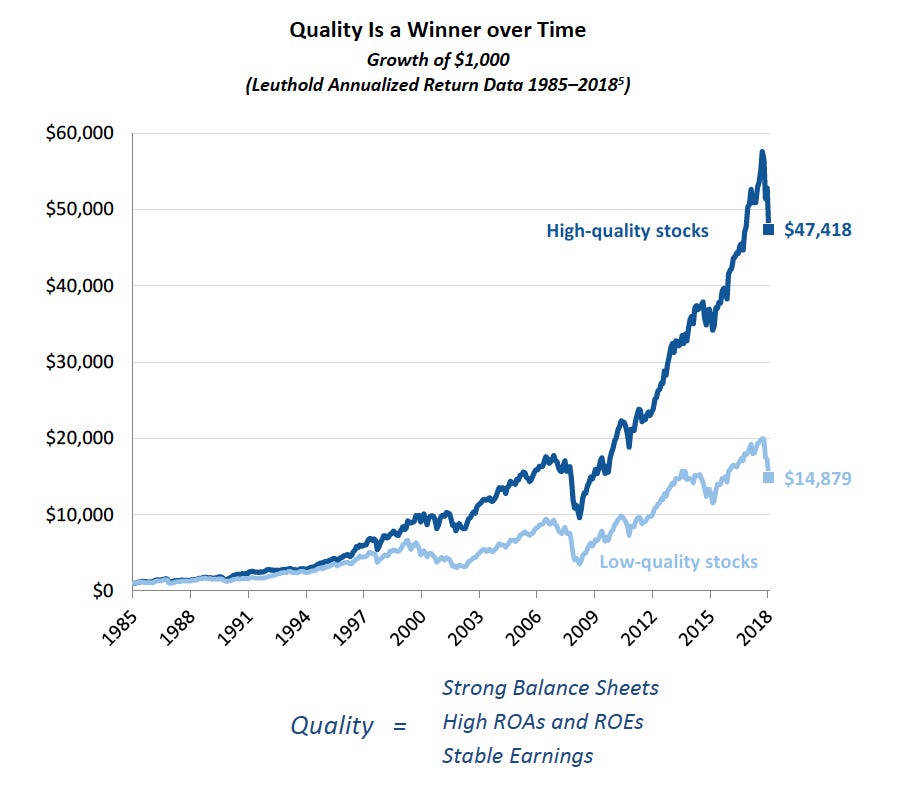Why not Microcap Investing for us?
The world of microcap stocks is an exciting, vast and rich place to allocate capital. Microcap stocks are publicly-traded companies with a typical market capitalisation of between US$50 million and US$300 million (note this does increase over time).
In the US alone, there are over 3,000 microcap stocks totalling nearly US$860 billion in market capitalisation, representing a small but important ~3% of the total US equity market.
What sparked our initial interest in Microcap stocks?
(1) Small beats big.
Microcap stocks beat Large-cap stocks over the long-term. The reasoning goes that smaller stocks can potentially have more far upside than large stocks, and can go up far more.
(2) Value is more important in Microcaps than Growth.
Not all microcaps are equal. Better to focus on value than growth.
(3) Even more important is Quality.
Seek quality especially for microcaps. Seek growing revenues, stable earnings, strong balance sheets (little debt, net cash) and solid profitability (high ROE and ROA). Generally avoid microcaps with lacklustre revenue growth, poor unit economics and poor profitability coupled with high debt. Skate to where the puck goes, not down the slippery slope.
(4) Microcaps tend to have much higher Insider Ownership.
We love founder-led and owned business with strong owner operators. The higher insider ownership with “skin in the game” is generally a net positive, as it aligns management interests very closely with that of shareholders for the long-term.
Why the Outperformance of Microcap Stocks?
Microcaps are in a (1) less efficient market place, largely stemming from (2) very low sell-side analyst research, which reduces the the dissemination of relevant information.
However the for-argument for Microcaps largely ends there for us…
Why then not Microcaps Investing?
(1) Poor Liquidity
The magnitude of illiquidity in Microcaps is poor. It can take days if not weeks to build a meaningful position, depending on (1) market capitalisation and (2) float (% freely traded stock).
Ultimately, we are looking for investing strategies that can scale as our fund size grows and becomes larger with time, not hampering and making it more and more difficult. If it takes time to enter, likely it will take just as much time to exit, if not more.
Microcaps are much less liquid and infrequently traded, ultimately that affects our entry and exit prices. If you are big enough, you become the whale in the market with one of the largest positions, which makes it potentially even harder for one to exit their long position.
(2) Smaller size negatively limits Scale.
A microcap investing strategylimits how big eventually our fund can grow to become, thus it is not “infinitely” scalable for us.
Microcaps are too small, too illiquid for us to make material sizeable investments. We rather gets our basics right to be positioned for the long term, and not having to pivot and change it mid-way.
(3) Top Dog in Small & Niche Markets
Microcaps generally tend to be top dogs in much smaller and niche markets, seldom are serving a large potential total addressable market (TAM). Because if they were, they would probably have been allowed to grow bigger for longer, and gone public later at a higher valuation (market capitalisation).
(4) High attention required.
Because of the general lack of information, constant monitoring and intense scrutiny, with much more extensive and longer due diligence is required. There is often very little to no room for errors. We do not have extensive time to keep monitoring all our portfolio companies at such comprehensive levels. Thus it could work for others, but not for us.
(5) High Portfolio Turnover
Anecdotal feedback from the top microcap investors, indicated that he held 35–40 stocks and only still holds 1–2 stocks of those at the end of a 5 year period. Investing for us is to be invested to buy, hold and add to our winners over the long-term. Structurally we have to keep finding great companies to invest in to replace existing ones, the math and probabilities of doing so makes it more challenging, and is likely to deteriorate over time, and could lead to eventual declining outperformance.
Closing Words…
Investing for us is about thinking in probabilities and possibilities for the long-term. However, the limitations of microcap investing far outweigh the benefits of investing in them for us. We believe microcap investing would continue to be around and would do well for many niche investors, but it is just not the right one for us.
The stock market has different players playing different games (day traders, speculators, indexers, growth investors, value investors, dividend investor, microcap investors, etc).
Everyone has different goals, time frames & risk tolerance. Ultimately know what specific game you are playing, and always focus on that.
Play the game that works best for you, not that of others.
4 Apr 2021 | Eugene Ng | Vision Capital Fund | eugene.ng@visioncapitalfund.co
Find out more about Vision Capital Fund.
You can read my prior Annual Letters for Vision Capital here. If you like to learn more about my new journey with Vision Capital Fund, please email me.
Follow me on Twitter/X @EugeneNg_VCap
Check out our book on Investing, “Vision Investing: How We Beat Wall Street & You Can, Too”. We truly believe the individual investor can beat the market over the long run. The book chronicles our entire investment approach. It explains why we invest the way we do, how we invest, what we look out for in the companies, where we find them, and when we invest in them. It is available for purchase via Amazon, currently available in two formats: Paperback and eBook.
Join my email list for more investing insights. Note that it tends to be ad hoc and infrequent, as we aim to write timeless, not timely, content.
This article is solely for informational purposes and is not an offer or solicitation for the purchase or sale of any security, nor is it to be construed as legal or tax advice. References to securities and strategies are for illustrative purposes only and do not constitute buy or sell recommendations. The information in this report should not be used as the basis for any investment decisions.
We make no representation or warranty as to the accuracy or completeness of the information contained in this report, including third-party data sources. The views expressed are as of the publication date and subject to change at any time.
Hypothetical performance has many significant limitations and no representation is being made that such performance is achievable in the future. Past performance is no guarantee of future performance.











